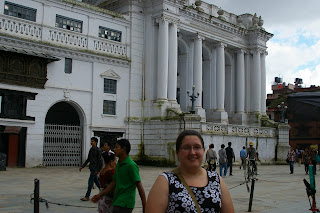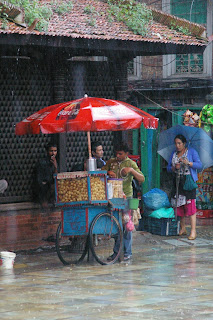We spent part of the morning going to the eye glass shop in
Chetrapati to replace our lenses with our newest prescriptions. I also picked
out a pair of prescription sunglasses. It will cost only 600 Nepali rupees for
the sunglasses, which is approximately $6.71 USD.
We then made our way to Basantapur, to Durbar Square, one of the World Heritage
Sites of Nepal. The
Durbar Square
is home to the former palace, several temples and pagodas, and the home of the
Kumari Devi, the living goddess. The Kumari is a young girl who for a few years
serves as a representation of the living goddess. There are many ceremonies
surrounding her and there are also limitations on how often she can be viewed
by the public.
At Durbar
Square there is the Hanumandhoka
Durbar Museum,
dedicated to the history of the previous kings of Nepal, specifically the most recent
and final four. Until recently, Nepal
had a monarchy system of government, that later became a constitutional
monarchy. In most recent years the monarchy was dissolved, and it is now a
multi-party democratic country, although still in its growing stages.
 |
| Nepali Dairy cow in Durbar Square. |
One of the most world renowned parties is the Maoist, who
were previously rebels against the former government of Nepal. While walking along a street
yesterday, I saw the headline on a news paper that, “after 9 years, US does not
consider Maoist party as terrorist.” Previously the United States had the party listed
as terrorists, and there were several travel advisories regarding this. They were
in part listed as terrorists because of the some of the violent actions that
took place in the country side, including the destruction of hydro-electric
dams, government buildings, and even burning of vehicles in the Kathmandu Valley. They engaged in gunfire with the Nepalese army
as well. Once the Maoist were integrated into the Nepalese government, many of
their soldiers became part of the current Nepali army. I am not the most savvy
in terms of the Maoist or political structure of Nepal,
but will probably share some more of what I have learned after we return to the
US.
The museum itself is in the historical palace.
Photos were not allowed, and we had to keep our cameras and bag in a locked
cabinet. The architecture is intriguing and I can’t even begin to guess what
each room is for. There is a small military/police barracks within the palace,
so portions are blocked off. My assumption is that things like kitchens and
pantries are in these areas, as they are working rooms that could be used in
the barracks.
 |
| A street vendor sells turmeric, ground coriander, and ground chili pepper in nearby Asan Thol. The only gold is that of turmeric that he must work so hard to bring and sell in the vibrant market. |
We walk quickly through the rest of the museum and many
courtyards to get back to the streets. Now that we can, we take a few photos
and I begin to tape some of the cityscape, people, and temples. I am doing a
wipe down shot of a stone pillar in the yard and…
“Madam.”
A tug at my elbow…a slight, dark complexion Nepalese woman
dressed in a faded black sari and mustard cholo. Vermillion tikka powder and
chamul covered her forehead. She may have been in her early 80s, or maybe
younger. She had a handful of assorted necklaces in her hand, made of bone,
wood, and jade beads. “Madam, sathi,” she again said raising the necklaces
towards my face. I tell her “no thank you” and she persists.
Bikash steps in and begins to explain that I am not a
tourist. (He taught me to say “Maf tourist hoina,” which I was not quick enough
to say). The camera lens turns from stone towards the conversation that has now
begun. He tells the woman that I am his wife (truth), I have no money (lie),
and that I live here (lie).
She does not seem to believe him. He then says that my name is “Malakar…Crystal Malakar.” She is “Newar.” The woman is now intrigued and gives me the thumbs up upon learning my last name. They banter back and forth about this situation and conclude that we will not buy anything at this time. She leaves us smiling and moves on to the next tourist passing by. Afterwards, when we are leaving the square, we will see her again, but this times she recognizes us, smiles and waves and doesn’t waste her time on us.
She does not seem to believe him. He then says that my name is “Malakar…Crystal Malakar.” She is “Newar.” The woman is now intrigued and gives me the thumbs up upon learning my last name. They banter back and forth about this situation and conclude that we will not buy anything at this time. She leaves us smiling and moves on to the next tourist passing by. Afterwards, when we are leaving the square, we will see her again, but this times she recognizes us, smiles and waves and doesn’t waste her time on us.
I consider using my Wisconsin
skills to milk this cow…but I resist the temptation.
After taking a few more shots it begins to drizzle. We pack
up the camera and camcorder quickly and discuss looking for food. We walk
around for a bit in search of the entrance for a roof top restaurant that I
went to before with Bikash’s father in 2009, but then it begins to pour. We
find an entry way and huddle with other people to get out of the rain. I spot
the entrance of the restaurant and we make a dash for it. The rain continues to
pour, but we are temporarily indoors, climbing the steps of the restaurant. We
get to the roof and head for the umbrellas. There already is a waiter, trying
to stay dry as well. We order chai (Nepali milk tea), bottled mineral water,
and two plates of momo: fried chicken momo and steamed buff momo.
In the mean time the cameras come out and we take some
photos. You can see Swayambhunath in the distance. The famed “Monkey Temple,”
where we have yet to go this trip.
Bikash and I from the Kathmandu
Roof Top Café in Basantapur.
 The rain slows down and we take time to rest upon the roof
top. Bikash talks for a while with the waiter. We are the only customers. After
we finish our chai, we decided to head back to the streets of Basantapur
district. Some of the side streets are much quieter than other parts of Kathmandu. There are still many motor bikes and every
building holds a some sort of shop. Homes are built upwards, side by side. The
juxtaposition of the original homes that are over 100 years old, with their
carved wood framed windows, next to the taller, more modern homes popping up
everywhere. Despite the age difference, load shedding does not discriminate
between them.
The rain slows down and we take time to rest upon the roof
top. Bikash talks for a while with the waiter. We are the only customers. After
we finish our chai, we decided to head back to the streets of Basantapur
district. Some of the side streets are much quieter than other parts of Kathmandu. There are still many motor bikes and every
building holds a some sort of shop. Homes are built upwards, side by side. The
juxtaposition of the original homes that are over 100 years old, with their
carved wood framed windows, next to the taller, more modern homes popping up
everywhere. Despite the age difference, load shedding does not discriminate
between them. |
| A street vendor selling marigolds in
Durbar Square.
|
The rain does not slow for long, and again another heavy
down pour. We rush back up the street to the Kastha Mandap
Temple, located in the
square. Ba has told me that this temple was made with only one single tree. Due
to the size of the temple, and the fact that it is entirely made of wood, I
find it hard to believe…ever the skeptic. None the less, it is an amazing,
modestly adorned temple, that serves not only to hold the place of worship for
the people, but acts as a shelter from the rain.
Kastha Mandap is the inspiration for the name of the city of
Kathmandu (or
maybe the city leant name to the temple?). Kathmandu’s
original name is “Kastha Mandu” which means “wood city of the valley.” Mandu is
very similar to mandala, and also emphasize the round shape of the valley, or
the shape of a mandala.
The temple house four statues of the god Ganesh, the god
with an elephant’s head. Ganesh is considered to be a protector of it’s
devotees, but also ensuring success and knowledge. The four different Ganesh
statues represent different things to pray for. Binyak is another word for
Ganesh. Each of the Ganesh are in a separate corner of this pagoda style wooden
temple. Each has its own stone shrine and bell.
 |
| Trying to stay dry from the rain while selling marigolds, know that this too shall pass... |
 |
| The children of porters staying dry |
Jal Binyak is for water. It is located near the meeting of
several rivers in the valley, in Chobar. Devotees pray for rain, water…for freedom
from natural disasters such as floods, due to rain.
Ridhhi Binyak is the Ganesh of education and strong mind.
Many may give puja to this statue before a test (like the SLC in Nepal) or if
they are trying to learn something new. This Ganesh has a small book in its
hand. Ba did not remember the original location of this Ganesh. When we find
out, I will post it.
 |
| Moving about after the rain fall slowed down. |
 |
| Shelter. |
 |
| Waiting. |









